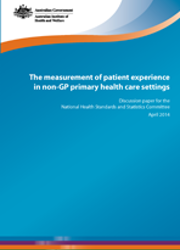Summary
Information about patient experience is important to guide health care quality improvement and may also be used for health performance reporting. While there have been developments in the capture of patient experience information in hospital and GP settings, little was known about the extent of data capture and in the broader non-GP primary health care sector.
To gain a better understanding of patient experience in the non-GP primary health care sector, the Australian Institute of Health and Welfare (AIHW) undertook this exploratory study to document current state/territory and nationally relevant data collections with a view to assessing options for compiling patient experience data in this sector.
The project was part of a broader 3-part project funded by the Australian Health Ministers' Advisory Council to develop patient experience data and indicators. This work was overseen by the National Health Information and Performance Principal Committee through its National Health Information Standards and Statistics Committee with broad input from the Patient Experience Information Development Working Group.
In undertaking this work, the AIHW consulted with relevant state/territory health authorities, the Australian Medicare Local Alliance, the Office for Aboriginal and Torres Strait Islander Health, the Consumers Health Forum and the Australian Bureau of Statistics.
Results
Overall, the study confirms that while there have been selected activities to validate and standardise patient experiences in the hospital and GP setting, there has been limited documentation of patient experiences within the non-GP primary health care sector.
Future options
If there is interest in measuring patient experience in non-GP primary health care settings, a number of options could be considered:
- Undertake further work to define primary health care and non-GP primary health care.
- Improve fundamental data capture of community health information, including patient experience data. One option could be to build on the Victorian Government's model, pending further development, validation, piloting and implementation of the Victorian patient experience tools.
- Build on the work of the Royal Australian College of General Practitioners accreditation process and/or the common hospital patient experience questions to develop standard agreed questions for adoption across primary health care settings.
- For a more population-based approach (as opposed to surveys of recent service recipients), priority non-GP primary health care services could be identified and the Australian Bureau of Statistics (ABS) Patient Experience Survey expanded to capture patient's experiences with a selection of these services. If adopted, it would be important to develop a consistent definition and understanding of what constitutes primary health care and, specifically, non-GP primary health care so that the population could respond consistently to questions on this subject.
A number of the above options could be pursued to help build a more complete picture of patient experience in non-GP primary health care settings.



